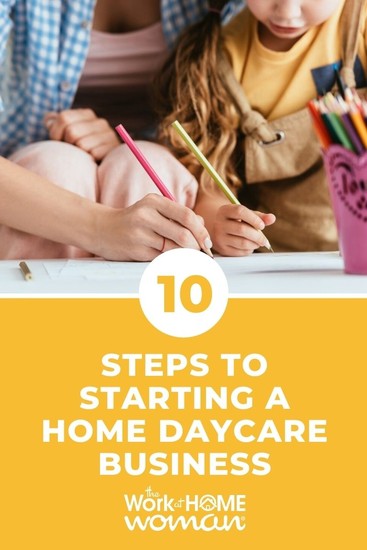Starting a home daycare business can be an excellent opportunity if you love kids and the prospect of being your own boss. Because you would be working from home, the startup costs can be low compared to many other businesses. Additionally, the rewards, both emotionally and financially, are potentially high.
There are many considerations when starting a home daycare business, and the requirements for such will vary from state to state. For a start, you will need to have some knowledge, or be willing to study, early childhood education so as to provide a suitable learning environment. You will also need to handle the business side of things, from licensing, regulations, and taxes.
If you feel like you have what it takes, whether you have your own children at home or not, let’s dive into the 10 steps involved in starting a home daycare business.

Step 1: Create a Business Plan
Before you even get started, it’s imperative to start thinking of it as a business, and the best way to do that is to create a business plan. Here is how to write one, plus a bonus free template.
Step 2: Structure Your Business
There are many different ways to legally structure your business, so talk to a legal or financial professional to help you determine which structure is best for your situation. You may wish to open your business as a sole proprietorship, LLC, S Corp, or Corporation. To discover the pros and cons of each structure, read What Business Structure is Right For Your Business?
Step 3: Secure the Funding
There are many small costs in setting up a home daycare that adds up considerably. For example, you’ll need educational supplies, toys, cleaning supplies, first-aid and CPR training, insurance, legal forms, a website, and registration. If you don’t have savings, check your local and state websites to see if there are any available grants or subsidies. The US Department of Health and Human Services is a good resource for where to get grants.
Step 4: Design Your Brand
To help your home daycare stand out, choose a great name and image for your business. You’ll need to consider brand colors, create a logo, and open social media accounts. You might find this article, 11 Branding Tips for Your Home-Based Business useful for getting started.
If you’re starting your home daycare business on a budget, check out Canva. It’s a free online design tool that can help you create a logo, brochures, social media images, and more! Best of all, it’s easy to use and will make you look like a pro! Just know that you won’t be able to trademark your image if you use a Canva template, as you don’t own the rights.
Step 5: Create a Budget
Now we’re getting into the nitty-gritty of running a business. Create a thorough budget of all your running expenses, and work out how many children and how much you will need to charge to cover the costs and provide a profit. The number of children you can take on will depend on staff-to-child ratios based on ages and criteria established by your state government. Read more on what these are on OPM.gov.
Step 6: Get an Insurance Plan
Accidents can and will happen, particularly in a daycare setting. You need to ensure that you’re business is covered for things like slips, falls, and any other unforeseen events. You’ll want to shop around and compare different business insurance plans (don’t forget to add this to your business budget).

Step 7: License Your Home Daycare
It’s in your and the prospective families’ best interest to license your business. Parents want assurance that they’re leaving their children in the best hands, in a place that meets all the standards for health and safety. In many locations, you will be expected to contact the department of child welfare or a similar agency to request an information pack.
Some jurisdictions may also include inspections as part of the application process. Also, check whether you need a separate business license by contacting your local department of licenses and inspections. Head to Daycare’s website for your state’s licensing laws.
Step 8: Decide on a Learning Approach
Learn about various childcare approaches and philosophies, and determine which one is right for your daycare setting. Some of the more common ones include Montessori, Reggio-Emilia, and Waldorf. Geteduca has a library of early learning curriculum goals, government, and state early learning guidelines, frameworks, and quality standards.
Step 9: Safety-Proof Your Home
Minimize accidents and be prepared for them by completing a first-aid course (such as the Red Cross training), having a fire emergency action plan in place, covering all electrical outlets, and securing furniture to the walls. The safety of the children should be your top priority.
Step 10: Get Paid
The last part of the equation is getting all of your financial ducks in a row. Work out how you will collect tuition, and open a business bank account. Find an accounting system that works for you and makes it easy to track payments and expenses, and send invoices. As a business owner, you’re responsible for paying quarterly self-employment taxes, be sure you understand all of your financial responsibilities.
Next Steps in Running Your Daycare Business
Now that you know the steps to start a home daycare business, you might be wondering what happens next.
As your business grows, you may consider hiring someone to help with some of your duties. You’re not just a group babysitter, so you will need to plan activities each day. Allocate time weekly to create lesson plans to engage and nurture the children in your care.
Parents will expect daily communication from you about their child, so you could either write reports or use an app that updates them in real-time and includes photos.
You’ll be required to replenish classroom supplies and furniture, so to reduce costs, keep an eye out online for second-hand furniture or free loose parts for play.
To get the word out there, you will need a good marketing strategy. You might like to distribute brochures locally, use social media, join local parenting Facebook Groups, list on a directory like Yelp, or advertise through Google.
Once you’ve become an established home daycare business, you might like to take it to the next level. By becoming accredited, parents will know that you’re following all of the necessary guidelines, and you may also be eligible for funding opportunities. Many states offer a Quality Rating and Improvement System (QRIS). Accreditation proves to parents that you’re among the best in your community, which of course, you want to be!







Leave a Comment